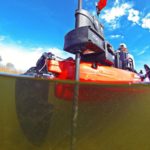
Anchoring a kayak at your preferred fishing spot doesn’t seem like a big deal. However, being able to quietly and precisely position the kayak provides for more comfortable and productive fishing.
If you’ve spent any amount of time around powerboat fishermen, you’ve undoubtedly seen some barrel up to a fishing spot and then noisily toss in an anchor with the zeal of an Olympic shot putter. They spend a few minutes fishing and then motor away because “there are no fish here.”
One of the advantages of using a kayak is the ability to move into a fishing spot quietly without spooking any fish.
Don’t ruin that advantage by noisily or improperly anchoring up.
Just as many fishing locations and situations are different, so too are the methods for anchoring and positioning your kayak to thoroughly and comfortably fish an area.
One device is usually not ideal for all situations, and you should plan ahead.
If you are going to fish shallow water with a soft bottom, a stake-out pole is an easy method to quickly and quietly anchor. Usually from 5 to 8 feet long, the stake-out pole is similar to what local power boaters generally call a “Cajun Anchor.”
However, instead of heavy stainless steel or aluminum, kayak stake-out poles are usually made of carbon or fiberglass and have a handle with a short length of rope on the top end. The pole’s bottom end has a point to make it easy to push into the mud to hold the kayak in place.
Stake-out poles stick up slightly above the water’s surface, depending on the length of the pole, the depth of the water and how far it can be pushed into the bottom for a secure hold.
Stake-out poles are available from a variety of commercial manufacturers, but can be simply made from a length of PVC pipe or even a wooden broom stick.
For deeper water, several small anchors are available that will hold a kayak in place, while being easy to retrieve. Selection of an anchor depends on several factors, including the make-up of the water bottom (mud, sand, rocks, etc.). The depth of the water and the strength of the wind or current also can dictate the style and weight of the anchor needed.
Small, lightweight, collapsible anchors are great for holding in soft bottoms where the wind or current is minimal. Rubber-coated dumbbells, metal barbell weights and even a simple brick can be used to anchor a kayak.
However, for rock-solid anchoring in sand or mud bottoms where the current is strong, a Bruce or Danforth-type anchor will hold tight without dragging. The pointed flukes dig in and provide a solid hold that is easy to retrieve. A short length of chain makes the anchor lie properly for best holding ability.
Many anchors are lost when set in areas that have snags or rocks on the bottom. Once wedged into a rock, it’s difficult to get enough leverage from the kayak to pull the anchor free.
Rigging the anchor with a “breakaway” link easily solves the problem. Fasten the chain to the bottom of the anchor and run it up the shaft to the usual attachment point. Attach the chain there with one or two small plastic zip ties. If the anchor gets hung, pull up the rope until you are directly over the anchor, and a few stout pulls on the rope will break the zip tie and allow the anchor to be pulled free due to the change in angle of the attachment point.
Keep a couple of spare zip ties onboard to reset the rig.
Kayaks do not regularly have cleats or many attachment points for an anchor rope. Consider adding one or two plastic cleats for tying off the anchor rope. A zigzag or clam cleat makes it easy to secure the rope, while offering a quick release without requiring a complicated knot.
This also allows the use of a small float on the end of the anchor line. If it becomes necessary to release from the anchor to fight a large fish or “unsnag” a fishing line, you can quickly toss the anchor line overboard without having to retrieve the anchor.
The use of one or two anchor trolleys greatly aids in getting the kayak at just the right angle to comfortably fish a precise area.
The trolley is simply a looped rope and some small pulleys that run alongside the kayak from bow to stern. A ring in the middle of the loop provides an attachment point or guide for the anchor line or stake-out pole.
This allows the anchor point to be easily changed along the kayak to adjust the angle that the ’yak sits while on anchor.
Mobility within the confines of the kayak is somewhat limited, and getting the ’yak in just the right position makes casting more comfortable.
Several manufacturers, like YakAttack, sell anchor trolley kits that can be used on a wide variety of kayaks.
Kayak anglers increasingly look to add the comforts of powerboat fishing to their fishing experience. This is no different when it comes to anchoring.
The introduction of the Power-Pole several years ago changed how many boaters anchor in shallow water. The hydraulic poles are operated with a remote control, and quietly and swiftly deploy a fiberglass rod to pin the boat to the bottom.
Not to be left out, kayakers now have a Power-Pole designed just for them. With the introduction of the Power-Pole Micro, kayaks and small skiffs can anchor just like the big boys.
Mounted on the rear of the kayak, the lightweight Power-Pole Micro raises and lowers a ¾-inch fiberglass spike to firmly anchor the kayak.
An onboard battery or the available lithium ion battery pack powers the 12-volt unit. The Micro is operated silently via a small remote control; at the press of a button, the kayak is anchored in just a few seconds.




